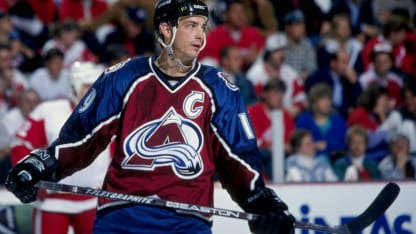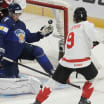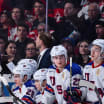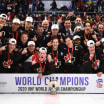Legendary hockey reporter Stan Fischler writes a weekly scrapbook for NHL.com. Fischler, known as "The Hockey Maven," shares his humor and insight with readers each Wednesday.
This week Fischler turns the calendar back 26 years with a fascinating tale about how a smash hit Hollywood movie altered a blockbuster NHL free agent signing.
In the summer of 1997, Colorado Avalanche superstar Joe Sakic was a free agent who wanted to sign with the New York Rangers.
By this point in his NHL career, Sakic had recorded 100 points or more four times in his first nine seasons. He was a perfect fit for the Rangers because Mark Messier departed that offseason to sign with the Vancouver Canucks and Sakic could slide in at center to form a 1-2 punch with Wayne Gretzky.
So, the Rangers were ready with a huge offer sheet, one they were convinced the Avalanche would not be able to match.
On Aug. 7, Sakic signed a three-year, $21 million offer sheet with the Rangers, one that featured $15 million up front as a signing bonus.
"[Madison Square Garden president Dave Checketts] was licking his lips with joy," hockey historian Sean McCaffrey wrote in his book “Ranger Killers.” "So was general manager Neil Smith, architect of the 1994 New York Cup Win. This looked like the perfect encore, just three years later."
It appeared to be a done deal and a major coup for New York. But not so fast.
Sakic never played a single shift for the Rangers. And if you're wondering who shared the blame for that, start with the scriptwriters and stars who worked for Comsat, the firm that produced the 1997 movie, "Air Force One," starring Harrison Ford.
Not that any moviemakers at Comsat -- which also owned the Avalanche -- were particularly interested in the Stanley Cup. Comsat had divested the Avalanche to its entertainment department arm called Ascent which had been hemorrhaging money.
All the Ascent filmmakers wanted was a hit movie that would lift the company out of the red. Of course, they couldn't know it at the time but Air Force One would be their savior.
The Rangers' screenplay, created by Checketts and Smith, had an Oscar look about it. The Garden vault was loaded with more than enough money to cover Sakic's contract. And the cash-strapped Avalanche, who had lost $8 million in 1996, also needed to invest in a new rink to replace 22-year-old McNichols Arena.
Meanwhile, Air Force One opened on Broadway and theaters around the country. It told the pulsating story of a group of terrorists who hijack Air Force One, and the President's attempt to rescue everyone on board by retaking the plane.
The film already had been critically acclaimed as both an artistic and fiscal hit. In its first week of showing, the movie made $37 million. Eventually, it would earn $315 million off its $85 million budget. But, more importantly for Colorado’s good and welfare, Ascent raked in $68.1 million from the major box office hit.
That unexpected windfall covered financing the proposed arena (which became Pepsi Center) and left enough money over for Ascent to match the Rangers' offer on Sept. 21.
"During an era where the words 'salary cap' weren't even a thought, the Avalanche now had more money in their coffers than they ever expected,” McCaffrey explained. “The movie cost the Rangers a chance to land Sakic. With Messier gone and Sakic still in Denver, the ‘Blueshirts’ wouldn't return to the playoffs for another nine years, the 2006 postseason."
Sakic played the rest of his career with the Avalanche, retiring in 2009. He’s played more games (1,378) than anyone in Avalanche/Quebec Nordiques history and is first all-time in goals (625), assists (1,016) and points (1,641). Sakic was inducted into the Hockey Hall of Fame in 2012.
As captain, he led the Avalanche to Stanley Cup championships in 1996 and 2001. As their general manager, he earned another Cup ring in 2022.
As for the Rangers?
"Had Air Force One not been a hit then who knows what would've happened," McCaffrey concluded. "Perhaps the Rangers would've won another Stanley Cup."


















